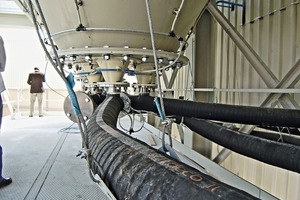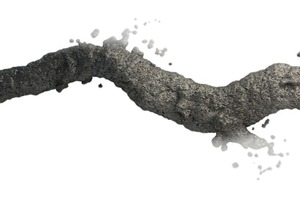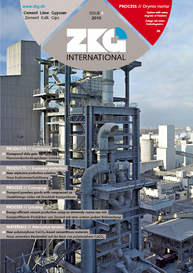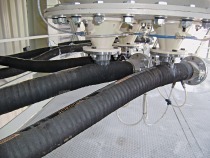With the flow
The processing of mortar at this time has not substantially changed – but the production and especially the handling and transport have. Completely new is a tube system from the Swedish manufacturer Trelleborg AB for the Spanish building materials manufacturer Grupo Puma. The transportation of cement mortar is done by means of compressed air, which puts the mortar in a fluid-like state so it can “flow”.
One of Spain’s largest producers of cement mortars is Grupo Puma, which has 20 plants located throughout the Iberian Peninsula. The group specializes in one-coat mortars ranging from decorative, cladding and grouting mortars to restoration, repair and insulation mortars, and its products are used in projects ranging from Valencia’s “City of Arts and Sciences” and Madrid’s Barajas Airport to skate parks and houses. Relatively new developments to Grupo Puma’s product range are adhesive and hydraulic mortars that can be used to render and fix insulating materials.
The working environment for cement production and transportation is inevitably dusty, causing atmospheric pollution that in turn affects industrial components such as electrical motors and fans used in screw and air slide systems – the commonly used traditional methods of transporting powders. In 2007, in response to tougher environmental regulations, Grupo Puma asked Trelleborg to install “Scirocco ll” hoses at its Seville plant. This system is radically different from the bulky, rigid screw conveyors and rigid air slides. Both of these need electric motors, one to operate the screw, the other to power an internal air fan. With “Scirocco ll” this is not necessary as it uses a fluidization process based on gravity flow.
This significantly reduces the energy consumed, making the process environmentally friendly. The entire cross section of the hose is used to transport powdered material. In the fluidization process, material in a granular solid state is converted into a fluid-like state by passing pressurized air through at an average pressure of 0.15-0.30 bars. The total system is completely sealed, eliminating dust pollution, and is virtually maintenance free.
“Our system needs only a small amount of air pressure to fluidize the product, as the design of the ‘Scirocco ll’ hose ensures that the air flow is consistent through the entire length of the hose,” says Ludovic Dumoulin, Product Manager for Trelleborg’s industrial hoses. “Gravity does the rest.”
The initial installation was so successful that Grupo Puma now uses the “Scirocco ll” system in its major manufacturing facilities in Seville, Valencia and Madrid. One of the unique properties of the system is that it is flexible, something Oscar Sanchez, Grupo Puma’s Director of Technical and Quality Services, sees as a particular advantage. “It allows us to upgrade older plants really easily,” he says. “The hoses can simply be threaded by hand through the forest of other pipes and supports in an older plant.” There are other benefits of the system too, says Sanchez. “Above all, the ‘Scirocco ll’ hose system is virtually maintenance-free. It uses a minimum of energy, is easy to install, allows for efficient transportation of cement and mortars and creates less atmospheric pollution. It’s an ideal product for us.”




